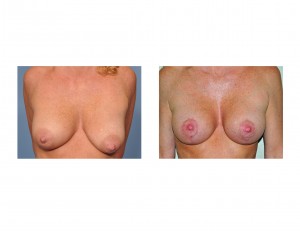When women are seen in consultation for breast augmentation, they are understandably enthusiastic about how the operation will change the appearance of their chest. Some will be surprised to learn, however, that they will need a breast lift with an implant to achieve the best result. Breast implants are perceived by some to have the ability to lift a sagging breast when, in some cases, they actually can create the need for it.
Conversely, a women may come in only requesting a lift for her breast sagging to discover that an implant will also be needed to get the best result. It is a misconception that a breast lift has the ability to make permanent upper pole fullness, one of the desired changes with a breast lift besides nipple repositioning.

For these reasons, I advise all women undergoing simultaneous breast implants and a lift that there is a high revision rate with this operation. It is not my goal to have to do a revision, nor is there any economic benefit for doing so, it is just a difficult operationThere are many reasons that the need for a revision may be desired including implant asymmetry, differences in mound shape or residual looseness of breast tissue and skin over the implant (bottoming out of beast tissue over the lower pole of the implant), some wide or persistent redness of the lift scars, nipple-areolar asymmetry, and adjustment of implant size. Given that breast augmentation alone has a 20% to 30% revision rate in the first three years after placement (national statistics from the manufacturer) should indicate how the ante goes up when a lift is added to the breast reshaping procedure.
The number that I like to imprint on a woman’s mind during the consultation process is a 50% risk of the need for revision for a combination breast implant and lift procedure. For many patients given their breast issues, the risk may not be that high. And my own practice experience indicates that, on average, it is not that high. (probably closer to 33%) But when significant breast sagging exists, the risk of revision may well be 50% or higher. At the least, it is anumber that captures the patient’s attention and makes it more than just an infrequent occurrence.
In breast augmentation lifting, there are numerous options based on how much sagging exists and what size of the breast a woman wants. It is a balance between how much breast scarring one can tolerate and how much upward movement of the nipple is acceptable in the face of the desired mound size. One other important consideration which exists in this combination breast operation is keeping the nipple alive. In either breast augmentation or breast lifting alone, this is virtually a non-issue. But when done together, maintaining a good blood supply to the nipple is , always a consideration. Too much skin tightening, too large of an implant, or too much breast tissue undermining can compromise the survival of the nipple. This is why in doing the procedure, if in doubt, I would rather ‘underlift’ the breast or place a smaller implant than risk having the nipple die. It is much easier to do a secondary breast reshaping/revision than it is to remake a nipple.
Without question, a simultaneous breast augmentation and breast lift combination is the most difficult body plastic surgery procedure to perform from an aesthetic perspective For this reason, some plastic surgeons prefer to separate the procedures into two stages in order to reduce the risks. This is a very acceptable approach although it does expose the patient to a 100% risk of a second surgery. (and maybe even a third) When done together, the risk of a second surgery (revision) is about half that of when it is staged.
Dr. Barry Eppley
Indianapolis, Indiana


